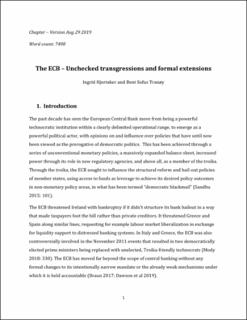| dc.contributor.author | Hjertaker, Ingrid | |
| dc.contributor.author | Tranøy, Bent Sofus | |
| dc.date.accessioned | 2022-12-16T12:58:01Z | |
| dc.date.available | 2022-12-16T12:58:01Z | |
| dc.date.created | 2021-07-07T19:11:43Z | |
| dc.date.issued | 2021 | |
| dc.identifier.citation | The Palgrave Handbook of EU Crises. 2021, 339–355. | en_US |
| dc.identifier.isbn | 978-3-030-51790-8 | |
| dc.identifier.uri | https://hdl.handle.net/11250/3038299 | |
| dc.description.abstract | This chapter suggests that the European Central Bank´s (ECB’s) changed role over the last 10 years can be conceptualized by three modes of crisis handling: Denial, Mission Creep, and Mission Leap. The ECB was never intended to be a lender of last resort, but with the financial crisis, this was precisely what eurozone financial institutions needed. As the crisis evolved, member states themselves needed a sovereign lender of last resort, something the ECB was explicitly designed not to be. TheECB has “muddled forward” to a position of considerable strength. In terms of outcomes, the monetary union is moving forward (Scenario 3thus, “muddling through” (Scenario 2) almost seems too weak a description of the constitutionally messy process that led the ECB through the crisis. | en_US |
| dc.language.iso | eng | en_US |
| dc.relation.ispartof | The Palgrave Handbook of EU Crises | |
| dc.relation.ispartofseries | Palgrave Studies in European Union Politics (PSEUP); | |
| dc.title | The European Central Bank | en_US |
| dc.type | Chapter | en_US |
| dc.description.version | acceptedVersion | en_US |
| dc.subject.nsi | VDP::Internasjonal politikk: 243 | en_US |
| dc.subject.nsi | VDP::International politics: 243 | en_US |
| dc.source.pagenumber | 339-355. | en_US |
| dc.identifier.doi | 10.1007/978-3-030-51791-5_18 | |
| dc.identifier.cristin | 1920831 | |
| cristin.ispublished | true | |
| cristin.fulltext | postprint | |
| cristin.qualitycode | 2 | |
